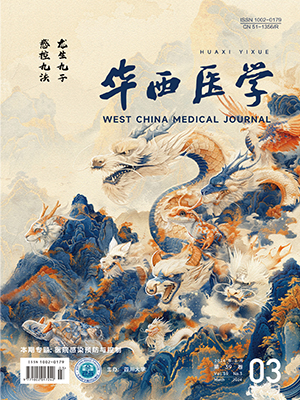| 1. |
Abrahamsen B, van Staa T, Ariely R, et al. Excess mortality following hip fracture: a systematic epidemiological review. Osteoporos Int, 2009, 20(10): 1633-1650.
|
| 2. |
孙家元, 张英泽. 老年髋部骨折围手术期处理. 国际骨科学杂志, 2013, 34(1): 11-14, 31.
|
| 3. |
Bhandari M, Swiontkowski M. Management of acute hip fracture. N Engl J Med, 2017, 377(21): 2053-2062.
|
| 4. |
Hu F, Jiang C, Shen J, et al. Preoperative predictors for mortality following hip fracture surgery: a systematic review and meta-analysis. Injury, 2012, 43(6): 676-685.
|
| 5. |
Hershkovitz A, Pulatov I, Brill S, et al. Can hip-fractured elderly patients maintain their rehabilitation achievements after 1 year?. Disabil Rehabil, 2012, 34(4): 304-310.
|
| 6. |
中华医学会外科学分会, 中华医学会麻醉学分会. 加速康复外科中国专家共识及路径管理指南(2018版). 中国实用外科杂志, 2018, 38(1): 1-20.
|
| 7. |
Kehlet H. Multimodal approach to control postoperative pathophysiology and rehabilitation. Br J Anaesth, 1997, 78(5): 606-617.
|
| 8. |
孙天胜, 沈建雄, 刘忠军, 等. 中国脊柱手术加速康复——围术期管理策略专家共识. 中华骨与关节外科杂志, 2017, 10(4): 271-279.
|
| 9. |
周宗科, 翁习生, 曲铁兵, 等. 中国髋、膝关节置换术加速康复——围术期管理策略专家共识. 中华骨与关节外科杂志, 2016, 9(1): 1-9.
|
| 10. |
Heller GZ, Manuguerra M, Chow R. How to analyze the Visual Analogue Scale: myths, truths and clinical relevance. Scand J Pain, 2016, 13: 67-75.
|
| 11. |
王赛华, 施加加, 孙莹, 等. 简体版改良Barthel指数在脑卒中恢复期中的信度与效度研究. 中国康复, 2020, 35(4): 179-182.
|
| 12. |
屈俊宏, 宁宁, 李佩芳, 等. 基于加速康复外科的骨科心理睡眠管理模式构建及效果评价. 华西医学, 2018, 33(9): 1168-1172.
|
| 13. |
Jin F, Chung F. Minimizing perioperative adverse events in the elderly. Br J Anaesth, 2001, 87(4): 608-624.
|
| 14. |
Roche JJ, Wenn RT, Sahota O, et al. Effect of comorbidities and postoperative complications on mortality after hip fracture in elderly people: prospective observational cohort study. BMJ, 2005, 331(7529): 1374.
|
| 15. |
Pedersen SJ, Borgbjerg FM, Schousboe B, et al. A comprehensive hip fracture program reduces complication rates and mortality. J Am Geriatr Soc, 2008, 56(10): 1831-1838.
|
| 16. |
Friedman SM, Mendelson DA, Bingham KW, et al. Impact of a comanaged Geriatric Fracture Center on short-term hip fracture outcomes. Arch Intern Med, 2009, 169(18): 1712-1717.
|
| 17. |
Reguant F, Arnau A, Lorente JV, et al. Efficacy of a multidisciplinary approach on postoperative morbidity and mortality of elderly patients with hip fracture. J Clin Anesth, 2019, 53: 11-19.
|
| 18. |
Liu VX, Rosas E, Hwang J, et al. Enhanced recovery after surgery program implementation in 2 surgical populations in an integrated health care delivery system. JAMA Surg, 2017, 152(7): e171032.
|
| 19. |
Grigoryan KV, Javedan H, Rudolph JL. Orthogeriatric care models and outcomes in hip fracture patients: a systematic review and meta-analysis. J Orthop Trauma, 2014, 28(3): e49-e55.
|
| 20. |
Ljungqvist O, Scott M, Fearon KC. Enhanced recovery after surgery: a review. JAMA Surg, 2017, 152(3): 292-298.
|
| 21. |
Veziant J, Raspado O, Entremont A, et al. Large-scale implementation of enhanced recovery programs after surgery. A francophone experience. J Visc Surg, 2017, 154(3): 159-166.
|
| 22. |
Slim K. Fast-track surgery: the next revolution in surgical care following laparoscopy. Colorectal Dis, 2011, 13(5): 478-480.
|
| 23. |
Sanzone AG. Current challenges in pain management in hip fracture patients. J Orthop Trauma, 2016, 30(Suppl 1): S1-S5.
|
| 24. |
Soffin EM, Gibbons MM, Ko CY, et al. Evidence review conducted for the agency for healthcare research and quality safety program for improving surgical care and recovery: focus on anesthesiology for total hip arthroplasty. Anesth Analg, 2019, 128(3): 454-465.
|
| 25. |
Soffin EM, YaDeau JT. Enhanced recovery after surgery for primary hip and knee arthroplasty: a review of the evidence. Br J Anaesth, 2016, 117(suppl 3): iii62-iii72.
|
| 26. |
Bell KE, von Allmen MT, Devries MC, et al. Muscle disuse as a pivotal problem in sarcopenia-related muscle loss and dysfunction. J Frailty Aging, 2016, 5(1): 33-41.
|
| 27. |
Vogler CM, Sherrington C, Ogle SJ, et al. Reducing risk of falling in older people discharged from hospital: a randomized controlled trial comparing seated exercises, weight-bearing exercises, and social visits. Arch Phys Med Rehabil, 2009, 90(8): 1317-1324.
|
| 28. |
Palm H, Teixidor J. Proximal femoral fractures: can we improve further surgical treatment pathways?. Injury, 2015, 46(Suppl 5): S47-S51.
|
| 29. |
Langenhan R, Trobisch P, Ricart P, et al. Aggressive surgical treatment of periprosthetic femur fractures can reduce mortality: comparison of open reduction and internal fixation versus a modularprosthesis nail. J Orthop Trauma, 2012, 26(2): 80-85.
|
| 30. |
Pfeufer D, Zeller A, Mehaffey S, et al. Weight-bearing restrictions reduce postoperative mobility in elderly hip fracture patients. Arch Orthop Trauma Surg, 2019, 139(9): 1253-1259.
|
| 31. |
龙也, 李浪, 王通, 等. 老年转子间骨折术后早期功能锻炼的效果研究. 华西医学, 2018, 33(9): 1124-1127.
|
| 32. |
Knauf T, Buecking B, Hack J, et al. Development of the Barthel Index 5 years after hip fracture: results of a prospective study. Geriatr Gerontol Int, 2019, 19(8): 809-814.
|
| 33. |
黎介寿, 江志伟. 加速康复外科的临床意义不仅仅是缩短住院日. 中华消化外科杂志, 2015, 14(1): 22-24.
|
| 34. |
李庭, 周雁, 孙旭, 等. 缩短创伤骨科择期手术患者围手术期禁食水时间的前瞻性队列研究. 中华创伤骨科杂志, 2018, 20(4): 312-317.
|
| 35. |
金占萍, 朱迎春, 王哲洋, 等. 老年髋部骨折手术患者围术期营养风险与营养摄入现况调查. 中华现代护理杂志, 2016, 22(36): 5240-5242.
|




